Evaluation of the Physical and Mechanical Properties of Short Entada mannii-Glass Fiber Hybrid Composites
Abstract
:1. Introduction
2. Materials and Methods
2.1. Materials
2.2. Fiber Chemical Modification
2.3. Composite Mixing and Extrusion Process
2.4. Density and Void Content
2.5. Moisture Absorption
2.6. Tensile Strength
2.7. Impact Strength
2.8. The Microhardness of the Composites
2.9. The Compressive Properties of the Composites
2.10. Characterization of the Composite Fracture Surface
3. Results and Discussions
3.1. Effect of Alkali Modification
3.2. The Assessment of Composite Void Contents
3.3. Assessment of the Moisture Absorption
3.4. Stress–Strain Plot of the Composites
3.5. Evaluation of the Tensile Strength of the Composites
3.6. Young’s Modulus of the Reinforced Composites
3.7. Compressive Strength and Modulus Fabricated Composites
3.8. Comparison of the Impact Strength
3.9. Micro Hardness Properties
3.10. Scanning Electron Micrograph of the Fracture
4. Conclusions
Author Contributions
Funding
Institutional Review Board Statement
Informed Consent Statement
Conflicts of Interest
References
- Xu, Z.; Yang, L.; Ni, Q.; Ruan, F.; Wang, H. Fabrication of high-performance green hemp/polylactic acid fibre composites. J. Eng. Fibers Fabr. 2019, 14, 1–9. [Google Scholar] [CrossRef] [Green Version]
- Aisyah, H.A.; Paridah, M.T.; Sapuan, S.M.; Ilyas, R.A.; Khalina, A.; Nurazzi, N.M.; Lee, S.H.; Lee, C.H. A Comprehensive Review on Advanced Sustainable Woven Natural Fibre Polymer Composites. Polymers 2021, 13, 471. [Google Scholar] [CrossRef] [PubMed]
- Chin, S.C.; Tee, K.F.; Tong, F.S.; Doh, S.I.; Gimbun, J. External Strengthening of Reinforced Concrete Beam with Opening by Bamboo Fiber Reinforced Composites. Mater. Struct. 2020, 53, 141. [Google Scholar] [CrossRef]
- Panaitescu, D.M.; Fierascu, R.C.; Gabor, A.R.; Nicolae, C.A. Effect of hemp fiber length on the mechanical and thermal properties of polypropylene/SEBS/hemp fiber composites. J. Mater. Res. Technol. 2020, 9, 10768–10781. [Google Scholar] [CrossRef]
- Balogun, O.P.; Omotoyinbo, J.A.; Alanme, K.K.; Adeniran, A.A. Physical and mechanical properties of Entada mannii particulates reinforced composites. Heliyon 2020, 6, e04157. [Google Scholar] [CrossRef] [PubMed]
- Balogun, O.P.; Omotoyinbo, J.A.; Alaneme, K.K.; Adeniran Oladele, I.O. Evaluation of Water Diffusion Mechanism on Mechanical Properties of Polypropylene composites. Int. J. Polym. Sci. 2020, 2020, 1–12. [Google Scholar] [CrossRef]
- Kada, D.; Migneault, S.; Tabak, G.; Koubaa, A. Physical and mechanical properties of pp wood- carbon fiber hybrid composites. BioResources 2016, 11, 1399–1406. [Google Scholar] [CrossRef] [Green Version]
- Jaspins, G.; Franciszczak, P.; Kalnin, K.; Kovalov, A. Mechanical properties of polypropylene biocomposites reinforced with Man-made cellulose fiber and cellulose microfiber. In IOP Conference Series: Materials Science and Engineering; IOP Publishing: Bristol, UK, 2019; Volume 500, p. 012008. [Google Scholar]
- Das, S.; Rahman, M.; Hasan, M. Physico-Mechanical Properties of Pineapple Leaf and Banana Fiber Reinforced Hybrid Polypropylene Composites: Effect of Fiber Ratio and Sodium Hydroxide Treatment. In IOP Conference Series: Materials Science and Engineering; IOP Publishing: Bristol, UK, 2018; Volume 438, p. 012027. [Google Scholar]
- Da Silva, R.V.; Voltz, H.; EItman Filho, A.; Milagre, M.X.; Machad, C.S.C. Hybrid composites with glass fiber and natural fibers of sisal, coir, and luffa sponge. J. Compos. Mater. 2020, 55, 717–728. [Google Scholar] [CrossRef]
- Graupner, N. Improvement of the mechanical properties of biodegradable hemp fiber reinforced polylactic acid) (PLA) composites by the admixture of man-made cellulose fibers. J. Compos. Mater. 2009, 43, 689–702. [Google Scholar] [CrossRef]
- Alavudeen, A.; Rajini, N.S.; Karthikeyan, S.; Thiruchitrambalam, M.; Venkateshwaren, N. Mechanical properties of banana/kenaf fiber-reinforced hybrid polyester composites: Effect of woven fabric and random orientation. Mater. Des. 2015, 66, 246–257. [Google Scholar] [CrossRef]
- Ramesh, M.; Palanikumar, K.; Reddy, K.H. Mechanical property evaluation of sisal–jute–glass fiber reinforced polyester composites. Compos. Part B Eng. 2013, 48, 1–9. [Google Scholar] [CrossRef]
- Afzaluddin, A.; Jawaid, M.; Salit, M.D.; Ishak, M.R. Physical and mechanical properties of sugar palm/glass fiber reinforced thermoplastic polyurethane hybrid composites. J. Mater. Res. Technol. 2018, 8, 950–959. [Google Scholar] [CrossRef]
- Bhoopathia, R.; Ramesha, M.; Deepa, C. Fabrication and Property Evaluation of Banana-Hemp-Glass Fiber Reinforced Composites. Procedia Eng. 2014, 97, 2032–2041. [Google Scholar] [CrossRef] [Green Version]
- Rodrigues, L.P.S.; Silva, R.V.; Aquino, E.M.F. Effect of accelerated environmental aging on mechanical behavior of curaua/glass hybrid composite. J. Compos. Mater. 2012, 46, 2055–2064. [Google Scholar] [CrossRef]
- Rahman, M.M.; Mondol, M.; Hasan, M. Mechanical Properties of Chemically Treated Coirand Betel Nut Fiber Reinforced Hybrid Polypropylene Composites. In IOP Conference Series: Materials Science and Engineering; IOP Publishing: Bristol, UK, 2018; Volume 438, p. 012025. [Google Scholar]
- Tusnim, J.; Jenifar NSHassan, M. Properties of jute and sheep wool fiber reinforced hybrid composite. In IOP Conference Series: Materials Science and Engineering; IOP Publishing: Bristol, UK, 2018; Volume 438, p. 012029. [Google Scholar]
- Begum, K.; Islam, M.A. Natural Fiber as a Substitute to Synthetic fiber in Polymer Composites; A Review. Res. J. Eng. Sci. 2013, 2, 46–53. [Google Scholar]
- AlMaadeed, M.A.; Kahraman, R.; Khanam, P.N.; Madi, N. Date palm wood flour/glass fibre reinforced hybrid composites of recycled polypropylene: Mechanical and thermal properties. Mater. Des. 2012, 42, 289–294. [Google Scholar] [CrossRef]
- Jeyanthi, S.; Janci Rani, J. Improving the Mechanical Properties by KENAF Natural long Fiber Reinforced Composite for Automotive Structures. J. Appl. Sci. Eng. 2012, 15, 275–280. [Google Scholar]
- Safri, S.N.A.; Sultan, M.T.H.; Jawaid, M.; Jayakrishna, K. Impact behaviour of hybrid composites for structural applications: A review. Compos. Part B Eng. 2018, 133, 112–121. [Google Scholar] [CrossRef]
- Shakuntala, O.; Raghavendra, G.; Kumar, A.S. Effect of Filler Loading on Mechanical and TribologicalProperties of Wood Apple Shell Reinforced Epoxy Composite. Adv. Mater. Sci. Eng. 2014, 2014, 538651. [Google Scholar] [CrossRef] [Green Version]
- Ali-Eldin, S.S.; Abd El-Moezz, S.M.; Megahed, M.; Abdalla, W.S. Study of Hybridization Effect of New Developed Rice Straw mat/Glass Fiber Reinforced Polyester Composite. J. Nat. Fibers 2021, 18, 1194–1206. [Google Scholar] [CrossRef]
- Balogun, O.P.; Omotoyinbo, J.A.; Alaneme, K.K. Structural characteristics, thermal degradation behaviour, and tensile properties of hand extracted Entada Mannii Fibres. J. Phys. Sci. 2016, 27, 89–102. [Google Scholar]
- Bledzki, A.K.; Mamun, A.A.; Jaszkiewicz, A.; Erdmann, K. Polypropylene composites with enzyme modified abaca fibre. Compos. Sci. Technol. 2012, 70, 854–860. [Google Scholar] [CrossRef]
- Hoque, M.B.; Solaiman, A.B.M.; Alam, H.; Mahmud, H.; Nobi, A. Mechanical, Degradation and Water Uptake Properties of Fabric Reinforced Polypropylene Based Composites: Effect of Alkali on Composites. Fibers 2018, 6, 94. [Google Scholar] [CrossRef] [Green Version]
- Kumre, A.; Rana, R.S.; Puohit, R. A Review on Mechanical Properties of Sisal Glass Fiber Reinforced Polymer Composites. Mater. Today Proc. 2017, 4, 3466–3476. [Google Scholar]
- Musa, L.; Rozyanty, A.R.; Zhafer, S.F. Effect of Modification Time of Kenaf Bast Fiber with Maleic Anhydride on Tensile Properties of Kenaf-Glass Hybrid Fiber Unsaturated Polyester Composites. Solid State Phenom. 2018, 280, 353–360. [Google Scholar] [CrossRef]
- Premnath, A.A. Impact of surface treatment on the mechanical properties of sisal and jute reinforced with epoxy resin natural fiber hybrid composites. J. Nat. Fibers 2018, 16, 718–728. [Google Scholar] [CrossRef]
- Balaban, A.C.; Tee, K.F.; Toygar, M.E. Low Velocity Impact Behaviour of Sandwich Composite Structures with E-Glass/Epoxy Facesheets and PVC Foam. Procedia Struct. Integr. 2019, 18, 577–585. [Google Scholar] [CrossRef]
- Toygar, M.E.; Tee, K.F.; Maleki, F.K.; Balaban, A.C. Experimental, Analytical and Numerical Study of Mechanical Properties and Fracture Energy for Composite Sandwich Beams. J. Sandw. Struct. Mater. 2019, 21, 1167–1189. [Google Scholar] [CrossRef]
- Khan, M.Z.R.; Srivastava, S.R.; Gupta, M.K. Hybrid wood particulates composites: Mechanical and thermal properties. Mater. Res. Express 2019, 6, 105323. [Google Scholar] [CrossRef]
- Chaudhary, V.; Bajpai, P.K.; Maheshwari, S. Studies on Mechanical and Morphological Characterization of Developed Jute/Hemp/Flax Reinforced Hybrid Composites for Structural Applications. J. Nat. Fibers 2018, 15, 80–97. [Google Scholar] [CrossRef]
- Masumder, M.R.H.; Numera, F.; Al-Asif, A.; Hasan, M. Mechanical Properties of Silk and Glass Fiber Reinforced Hybrid Polypropylene Composites. In IOP Conference Series: Materials Science and Engineering; IOP Publishing: Bristol, UK, 2018; Volume 438, p. 012007. [Google Scholar]
- Kushwaha, P.K.; Kumar, R. The studies on performance of epoxy and polyester-based composites reinforced with bamboo and glass fibers. J. Reinf. Plast. Compos. 2010, 29, 1952. [Google Scholar] [CrossRef]
- Arumugam, S.; Kandasamy, J.; Md Shah, A.U.; Sultan, M.T.H.; Safri, S.N.A.; Majid, M.S.A.; Basri, A.A.; Mustapha, F. Investigations on the Mechanical Properties of Glass Fiber/Sisal Fiber/Chitosan Reinforced Hybrid Polymer Sandwich Composite Scaffolds for Bone Fracture Fixation Applications. Polymers 2020, 12, 1501. [Google Scholar] [CrossRef] [PubMed]
- Atiqah, A.; Jawaid, M.; Sapuan, S.M.; Ishak, M.R. Effect of surface treatment on the mechanical properties of sugar palm/glass fiber-reinforced thermoplastic polyurethane hybrid composites. BioResources 2018, 13, 1174–1188. [Google Scholar] [CrossRef]
- Sapuan, S.M.; Aulia, H.S.; Ilyas, R.A.; Atiqah, A.; Dele-Afolabi, T.T.; Nurazzi, M.N.; Supian, A.B.M.; Atikah, M.S.N. Mechanical Properties of Longitudinal Basalt/Woven-Glass-Fiber-reinforced Unsaturated Polyester-Resin Hybrid Composites. Polymers 2020, 12, 2211. [Google Scholar] [CrossRef] [PubMed]
- Akter, M.; Jahan, E.; Hasan, M. Thermal and Morphological Properties of Pineapple and Betel Nut Husk Fiber Reinforced Hybrid Polypropylene Composites. In IOP Conference Series: Materials Science and Engineering; IOP Publishing: Bristol, UK, 2018; Volume 438, p. 012026. [Google Scholar]
- Haque, M.M.; Hasan, M. Influence of fiber surface treatment on physico-mechanical properties of betel nut and glass fiber reinforced hybrid polyethylene composites. Adv. Mater. Process. Technol. 2018, 4, 511–525. [Google Scholar] [CrossRef]
- Atiqah, A.; Jawaid, M.; Sapuan, S.M.; Ishak, M.R.; Ansari, M.N.M.; Ilyas, R.A. Physical and thermal properties of treated sugar palm/glass fibre reinforced thermoplastic polyurethane hybrid composites. J. Mater. Res. Technol. 2019, 8, 3726–3732. [Google Scholar] [CrossRef]
- Dikshit, V.; Goh, G.D.; Nagalingam, A.P.; Goh, G.L.; Yeong, W.Y. Recent progress in 3D printing of fiber-reinforced composite and nanocomposites. Fiber-Reinf. Nanocomposites Fundam. Appl. 2020, 4, 371–394. [Google Scholar]
- Sanjay, M.; Yogesha, R.B. Studies on Natural/Glass Fiber Reinforced Polymer Hybrid Composites: An Evolution. Mater. Today Proc. 2015, 2, 2959–2967. [Google Scholar] [CrossRef]
- Samal, S.K.; Mohanty, S.; Nayak, S.K. Banana/Glass Fiber-Reinforced Polypropylene Hybrid Composites: Fabrication and Performance Evaluation. Polym.-Plast. Technol. Eng. 2009, 48, 397–414. [Google Scholar] [CrossRef]
- Tripathi, P.; Gupta, V.K.; Dixit, A.; Mishra, R.K.; Sharma, S. Development and characterization of low cost jute, bagasse and glass fiber reinforced advanced hybrid epoxy composites. AIMS Mater. Sci. 2018, 5, 320–337. [Google Scholar] [CrossRef]
- Palanikumar, K.; Ramesh, M.; Reddy, K.M. Experimental Investigation on the Mechanical Properties of Green Hybrid Sisal and Glass Fiber Reinforced Polymer Composites. J. Nat. Fibers 2016, 13, 321–331. [Google Scholar] [CrossRef]
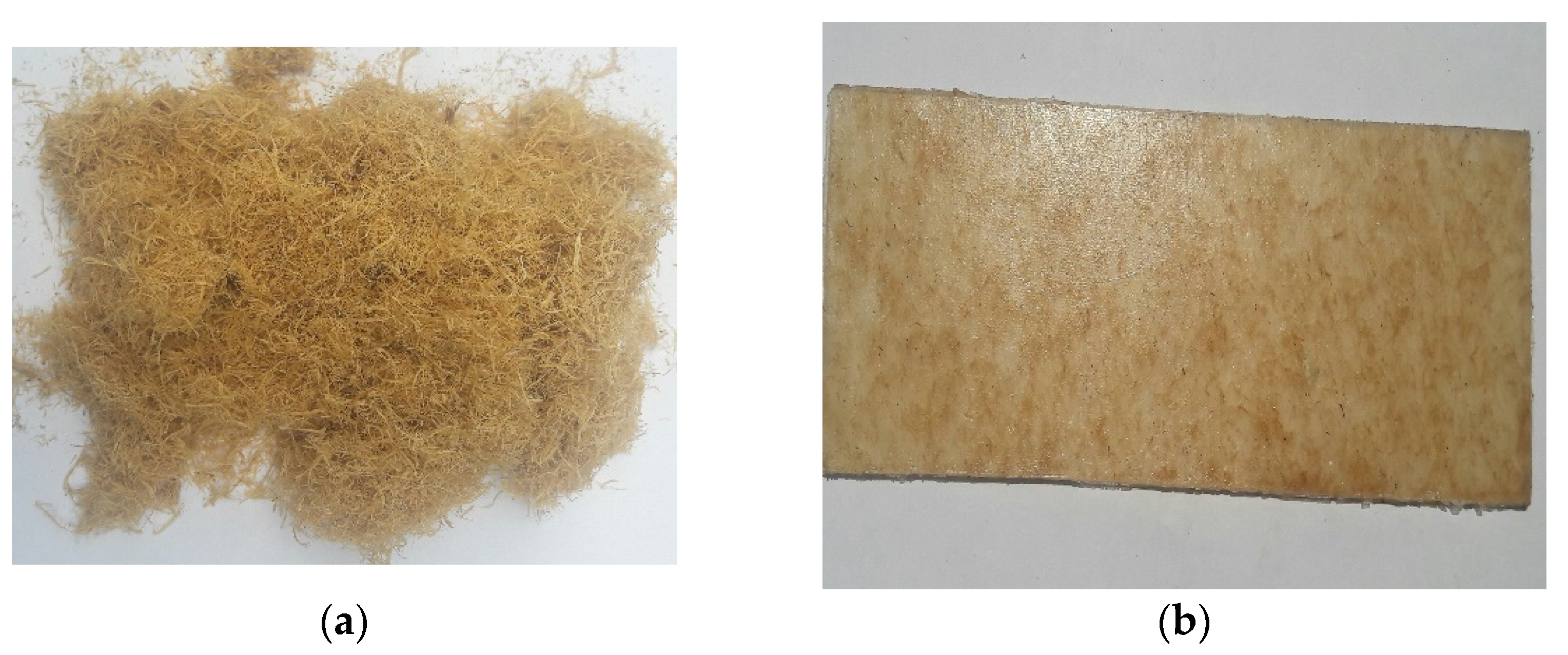
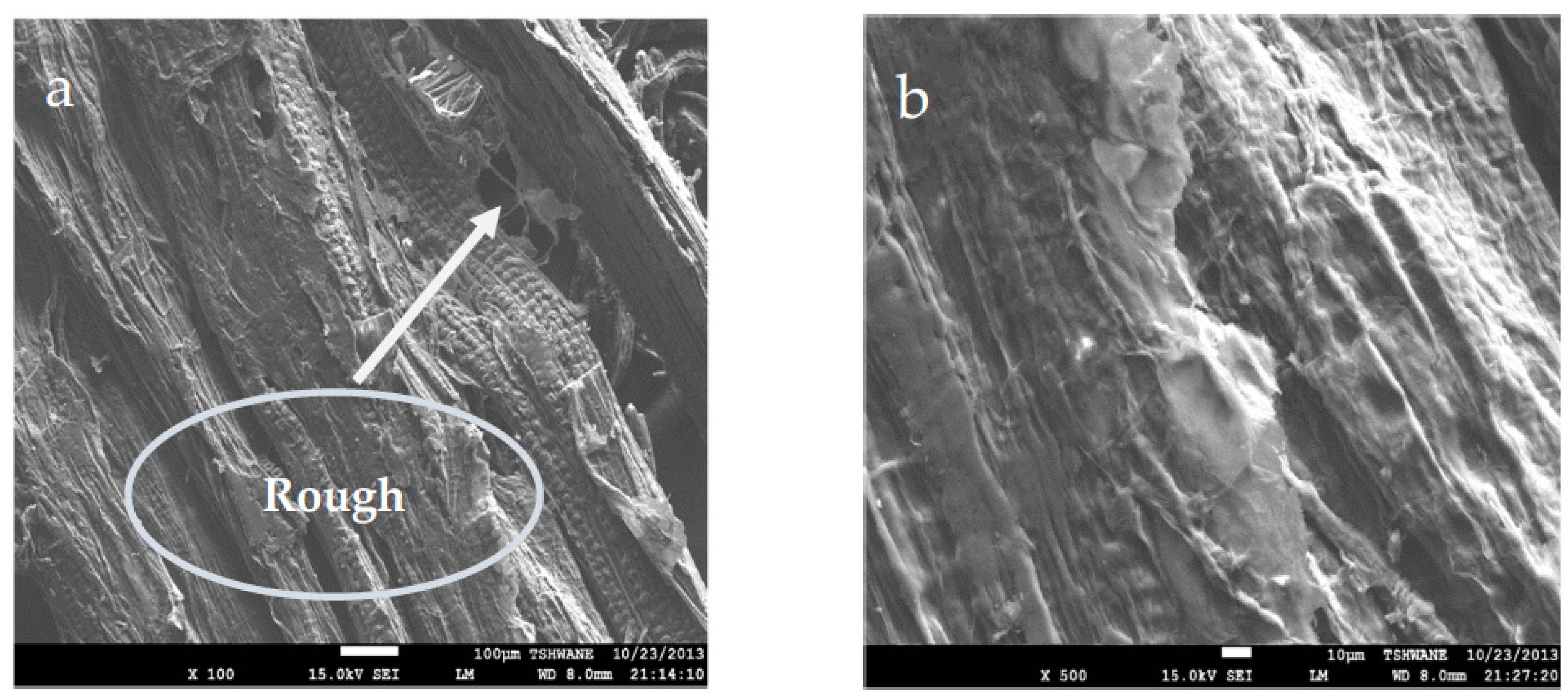
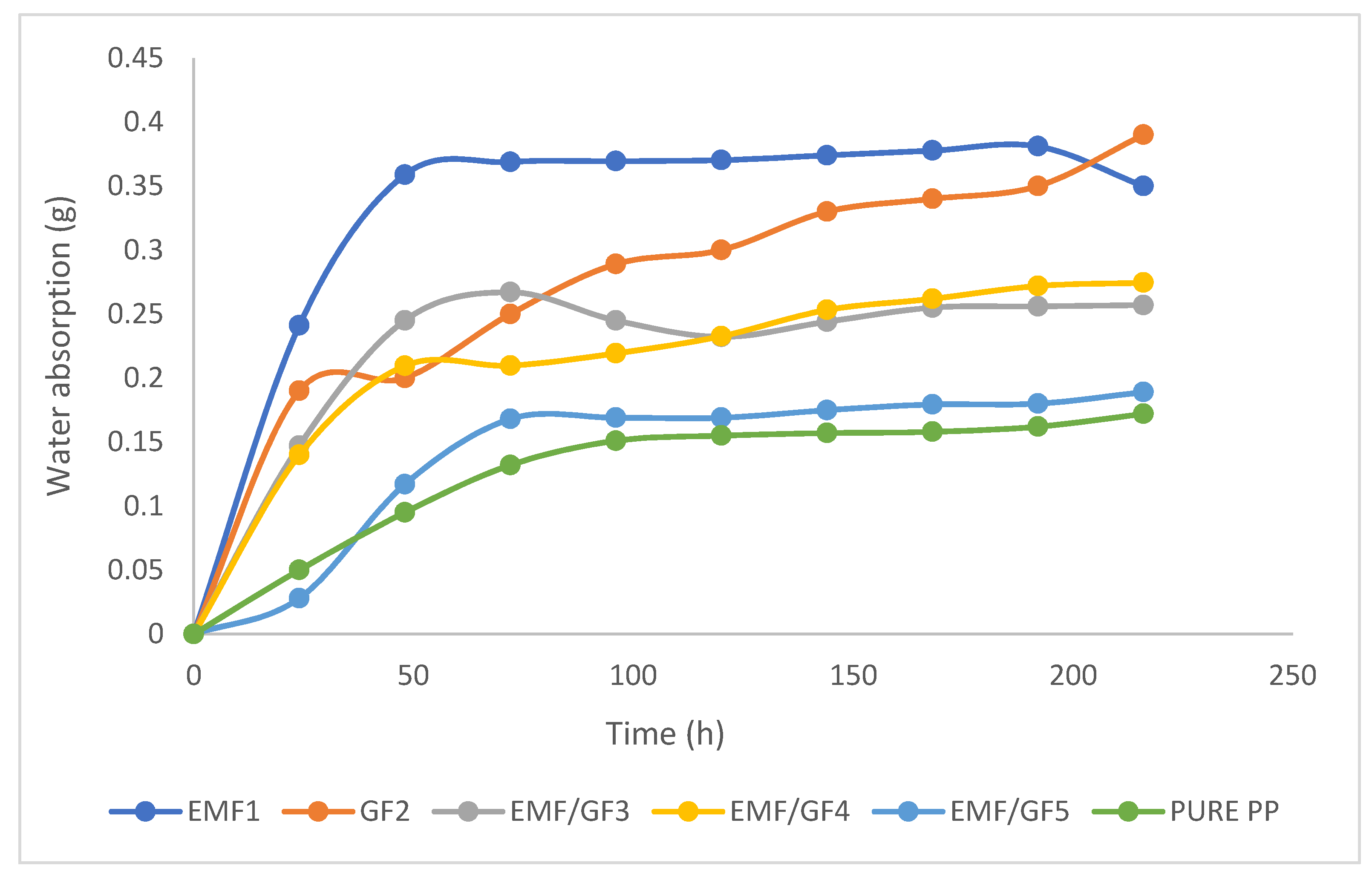

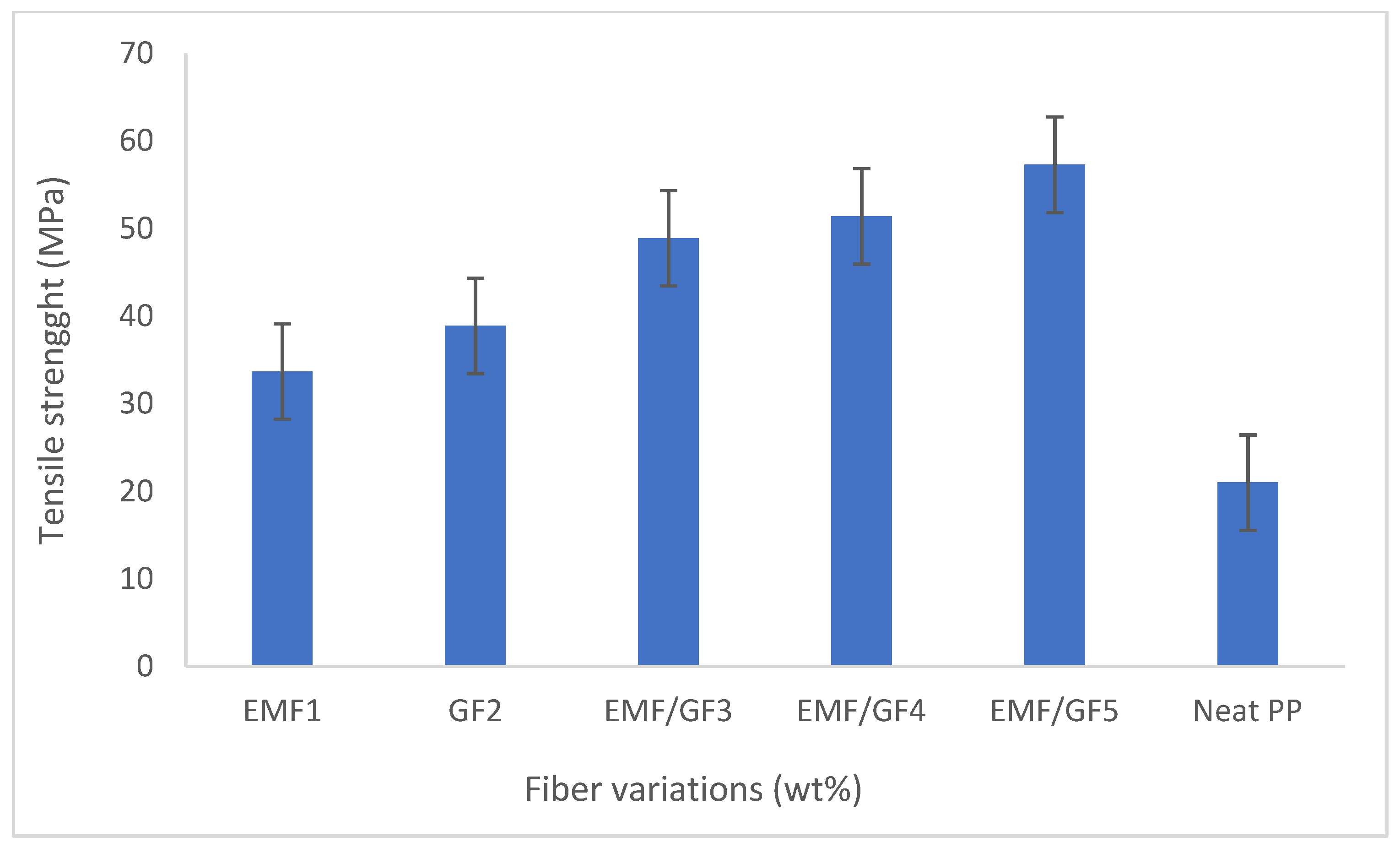
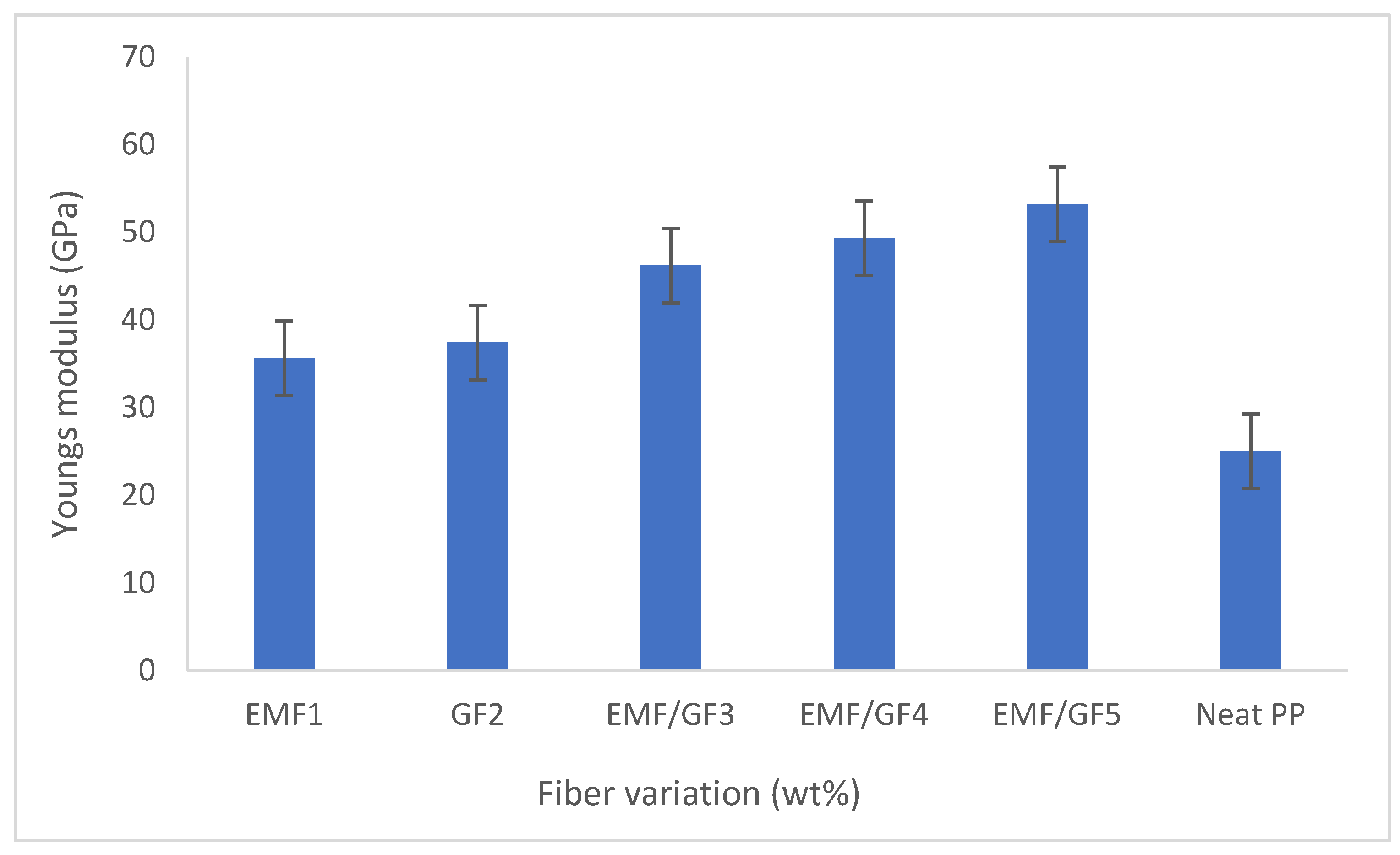
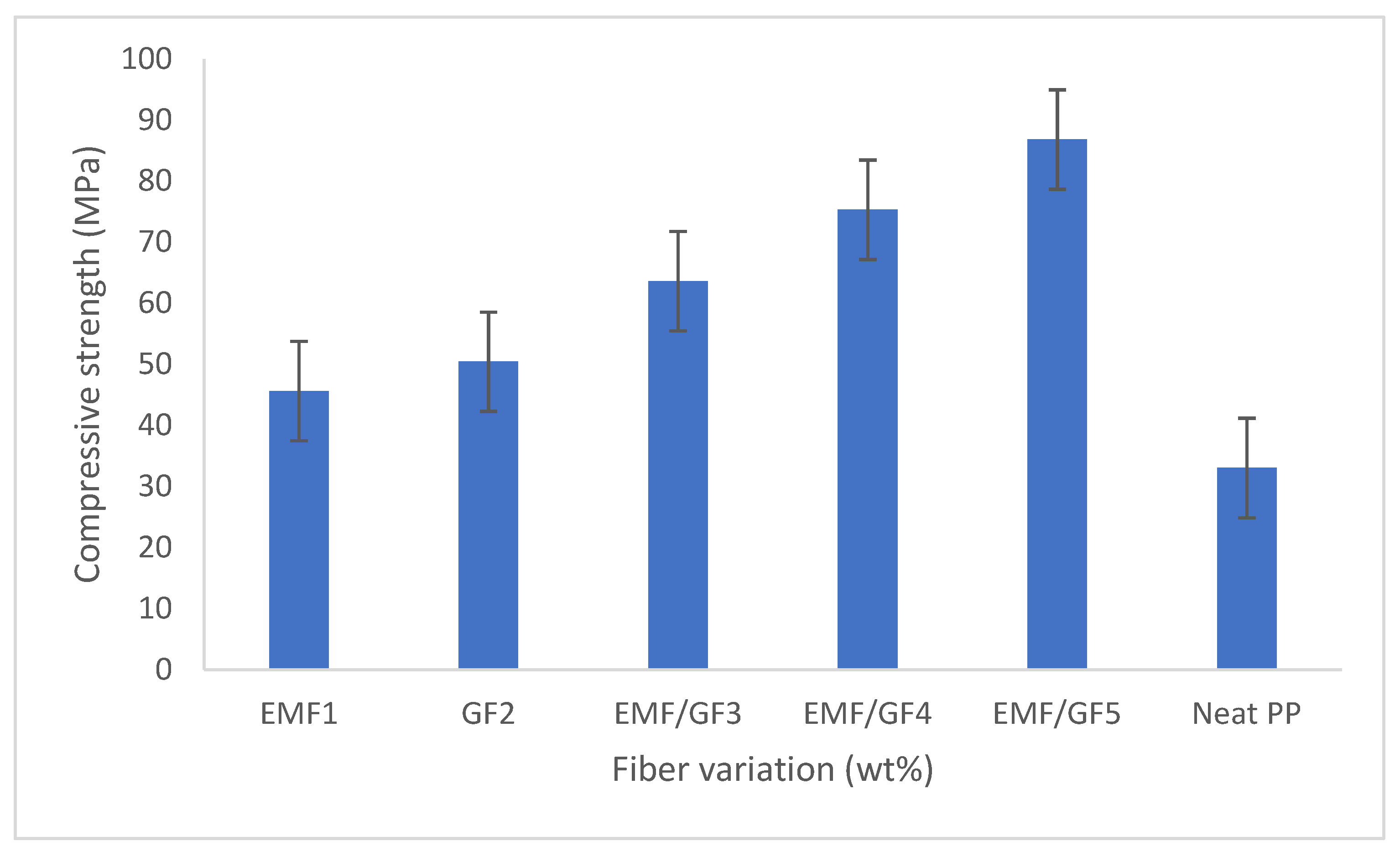
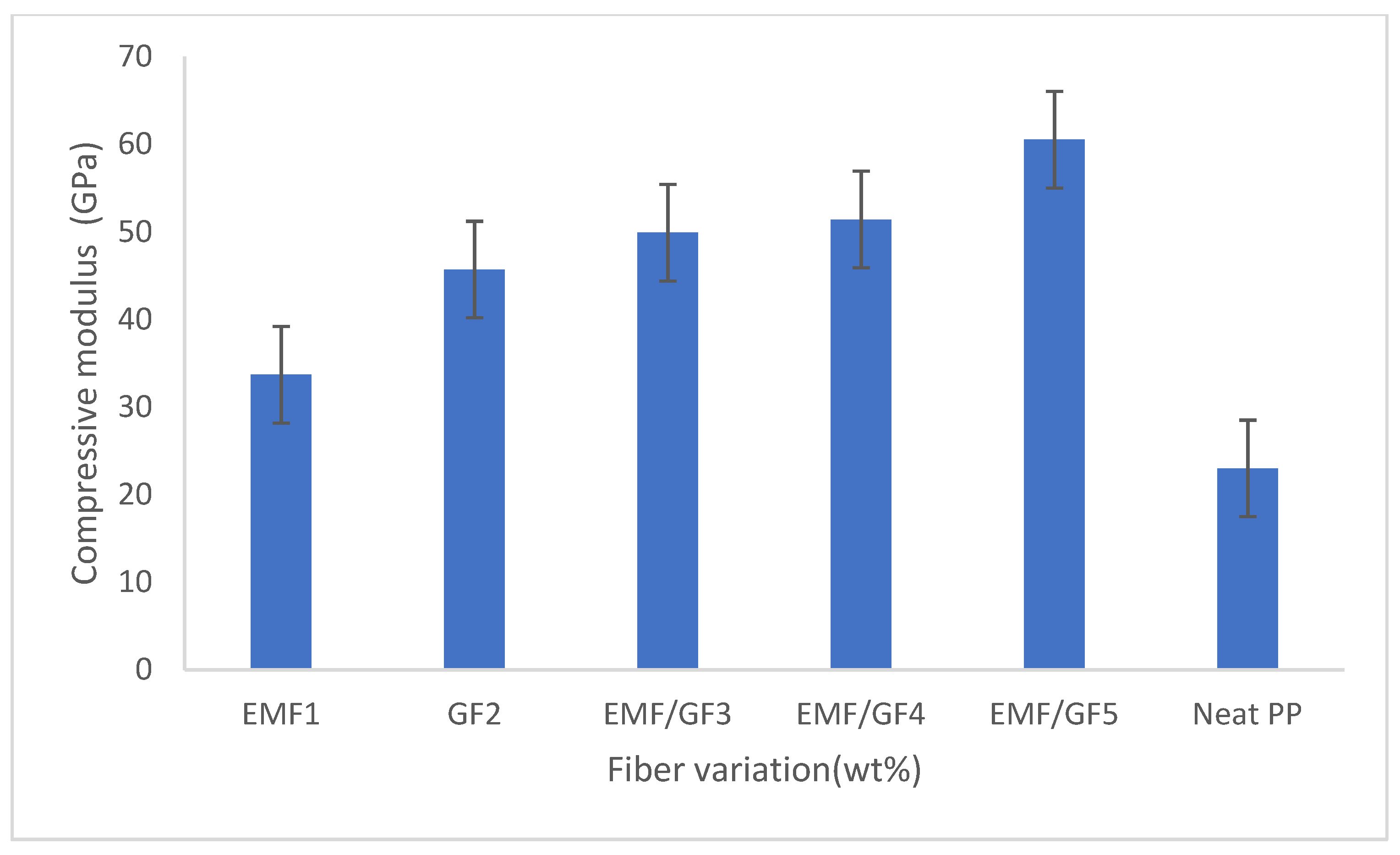
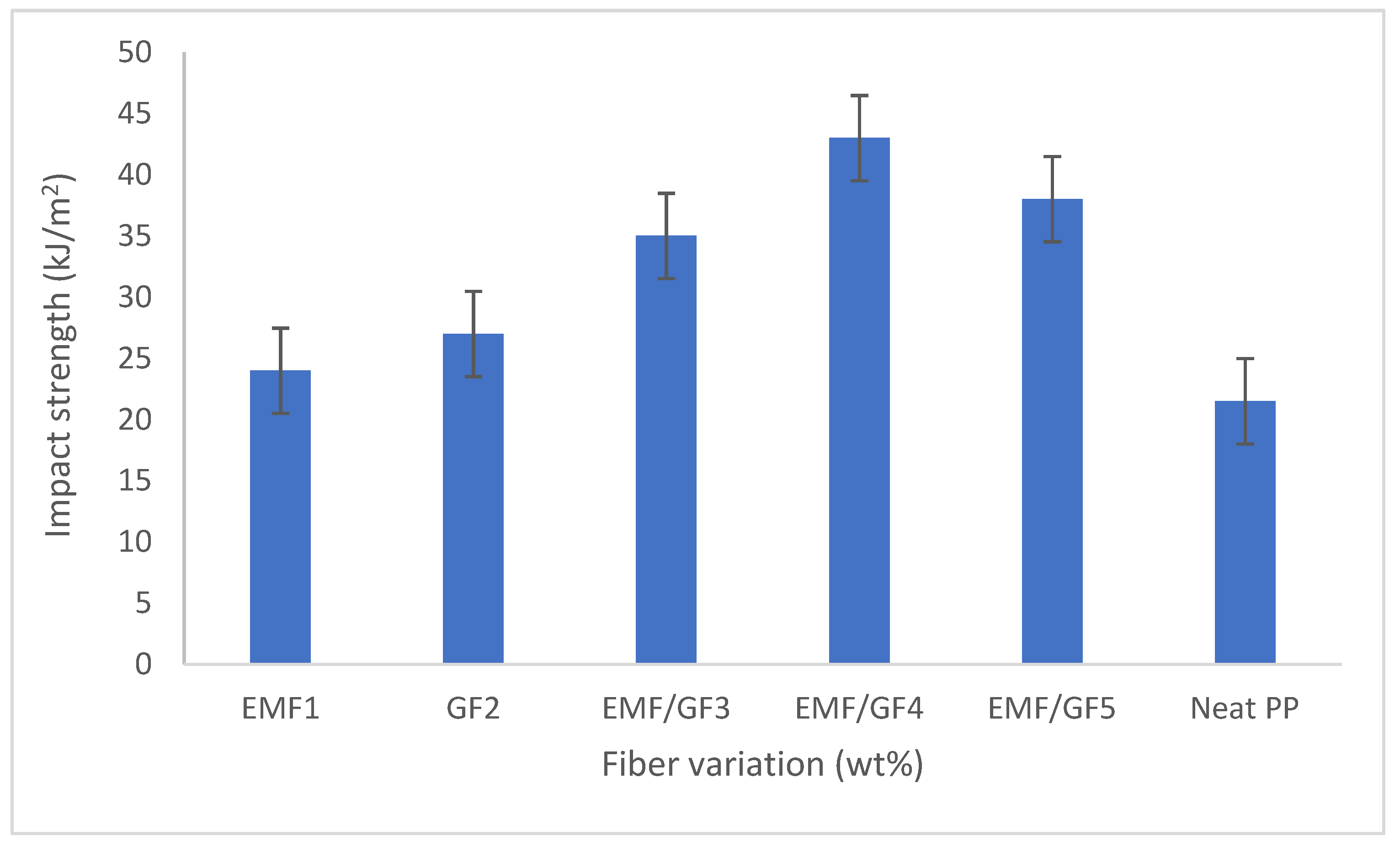
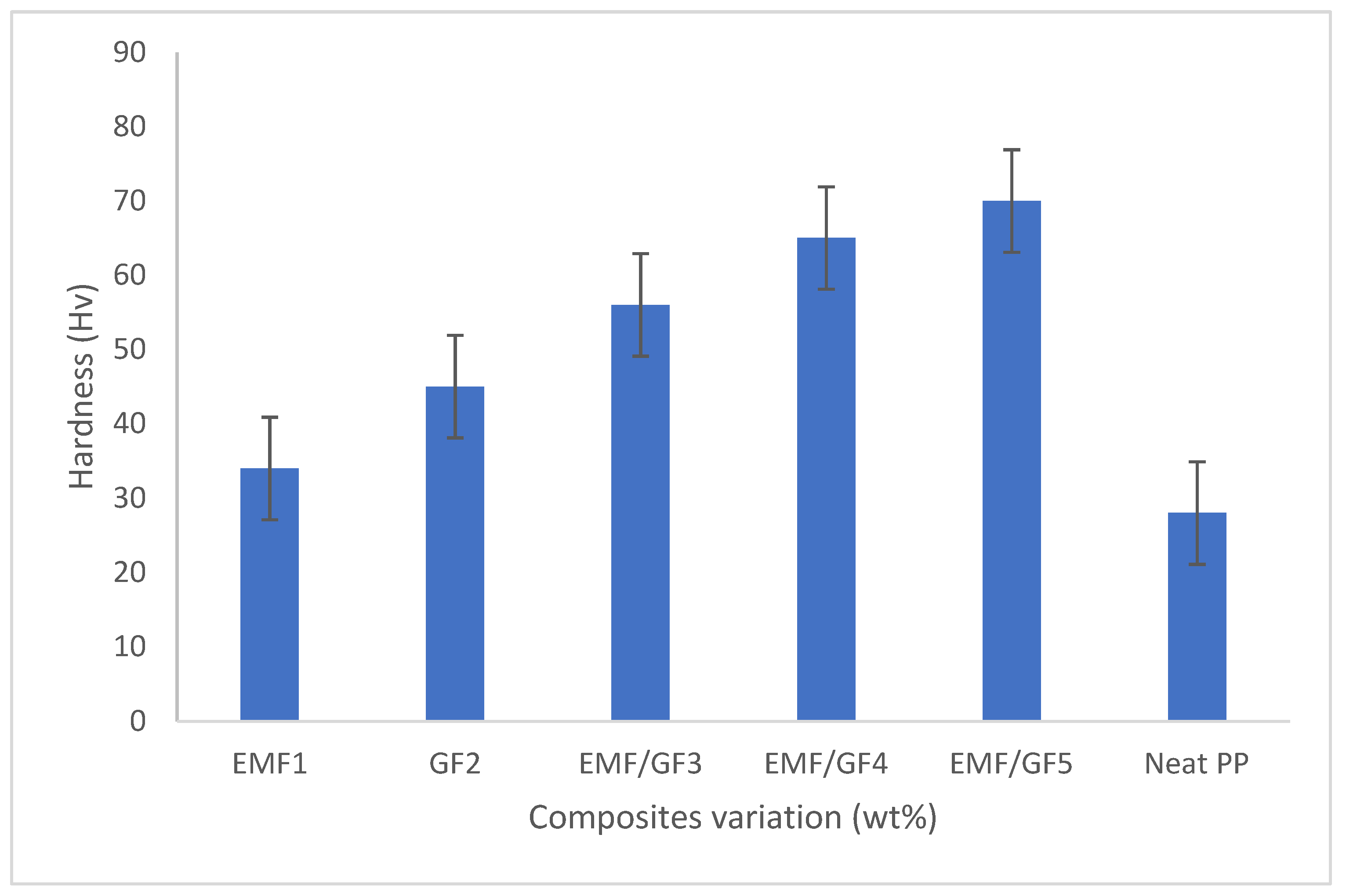

| Code | EMF | GF | PP | Theoretical Density | Experimental Density | Void |
|---|---|---|---|---|---|---|
| (wt%) | (wt%) | (wt%) | (g/cm3) | (g/cm3) | Content | |
| EMF1 | 20 | 0 | 80 | 1.1900 | 1.1830 | 0.5883 |
| GF2 | 0 | 20 | 80 | 1.1820 | 1.1752 | 0.5753 |
| EMF/GF3 | 15 | 5 | 80 | 1.1801 | 1.1751 | 0.4237 |
| EMF/GF4 | 10 | 10 | 80 | 1.1728 | 1.1690 | 0.3240 |
| EMF/GF5 | 5 | 15 | 80 | 1.1790 | 1.1680 | 0.2482 |
| PPP | 0 | 0 | 100 | 1.1650 | 1.1589 | 0.1356 |
| Samples | % Lignin | % Ash Content | % Hemicellulose | % Cellulose | Density(g/cm3) |
|---|---|---|---|---|---|
| Treated (NaOH fiber) | 6.29 | 4.35 | 40.79 | 61.88 | 1.228 |
| (Untreated fiber) | 8.12 | 5.81 | 48.18 | 51.73 | 1.541 |
| Glass Fiber | - | - | - | - | 2.930 |
Publisher’s Note: MDPI stays neutral with regard to jurisdictional claims in published maps and institutional affiliations. |
© 2022 by the authors. Licensee MDPI, Basel, Switzerland. This article is an open access article distributed under the terms and conditions of the Creative Commons Attribution (CC BY) license (https://creativecommons.org/licenses/by/4.0/).
Share and Cite
Balogun, O.P.; Alaneme, K.K.; Adediran, A.A.; Oladele, I.O.; Omotoyinbo, J.A.; Tee, K.F. Evaluation of the Physical and Mechanical Properties of Short Entada mannii-Glass Fiber Hybrid Composites. Fibers 2022, 10, 30. https://doi.org/10.3390/fib10030030
Balogun OP, Alaneme KK, Adediran AA, Oladele IO, Omotoyinbo JA, Tee KF. Evaluation of the Physical and Mechanical Properties of Short Entada mannii-Glass Fiber Hybrid Composites. Fibers. 2022; 10(3):30. https://doi.org/10.3390/fib10030030
Chicago/Turabian StyleBalogun, Oluwayomi Peter, Kenneth Kanayo Alaneme, Adeolu Adesoji Adediran, Isiaka Oluwole Oladele, Joseph Ajibade Omotoyinbo, and Kong Fah Tee. 2022. "Evaluation of the Physical and Mechanical Properties of Short Entada mannii-Glass Fiber Hybrid Composites" Fibers 10, no. 3: 30. https://doi.org/10.3390/fib10030030
APA StyleBalogun, O. P., Alaneme, K. K., Adediran, A. A., Oladele, I. O., Omotoyinbo, J. A., & Tee, K. F. (2022). Evaluation of the Physical and Mechanical Properties of Short Entada mannii-Glass Fiber Hybrid Composites. Fibers, 10(3), 30. https://doi.org/10.3390/fib10030030







